RENAULT SANDERO 2012 User Guide
Manufacturer: RENAULT, Model Year: 2012, Model line: SANDERO, Model: RENAULT SANDERO 2012Pages: 183, PDF Size: 6.95 MB
Page 11 of 183
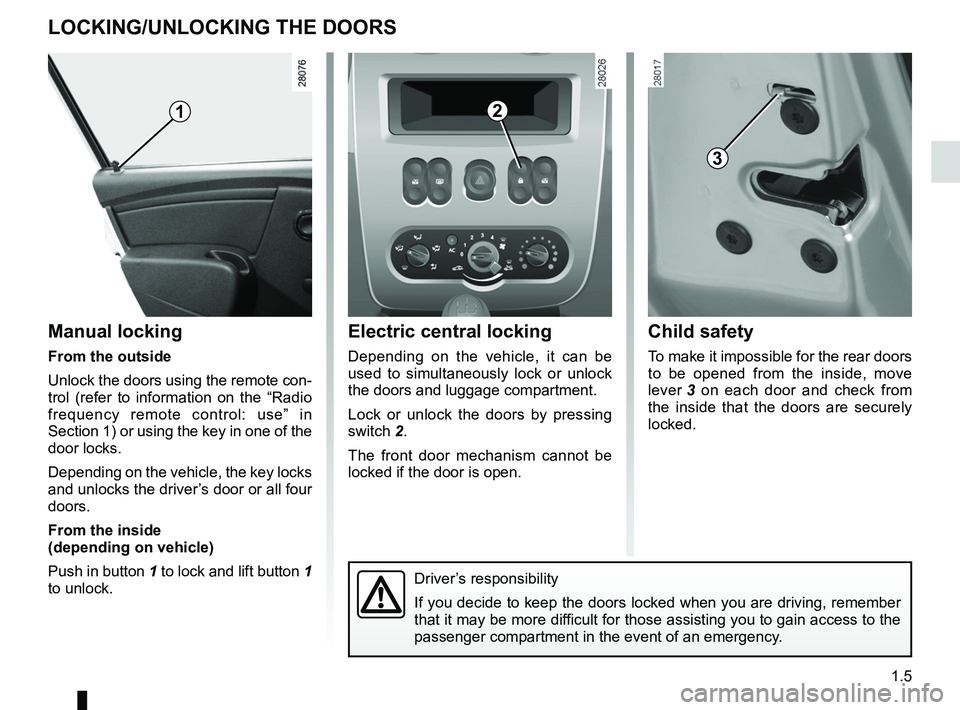
children ................................................. (up to the end of the DU)
doors ..................................................... (up to the end of the DU)
electric door locking .............................. (up to the end of the DU)
central door locking .............................. (up to the end of the DU)
1.5
ENG_UD19789_9
Verrouillage et déverrouillage des portes (B90 - L90 Ph2 - Dacia)
ENG_NU_817-9_B90_Dacia_1
Locking/unlocking the doors
LOCKING/UNLOCKING THE DOORS
Manual locking
From the outside
Unlock the doors using the remote con-
trol (refer to information on the “Radio
frequency remote control: use” in
Section 1) or using the key in one of the
door locks.
Depending on the vehicle, the key locks
and unlocks the driver’s door or all four
doors.
From the inside
(depending on vehicle)
Push in button 1 to lock and lift button 1
to unlock.
Electric central locking
Depending on the vehicle, it can be
used to simultaneously lock or unlock
the doors and luggage compartment.
Lock or unlock the doors by pressing
switch 2.
The front door mechanism cannot be
locked if the door is open.
Child safety
To make it impossible for the rear doors
to be opened from the inside, move
lever 3 on each door and check from
the inside that the doors are securely
locked.
Driver’s responsibility
If you decide to keep the doors locked when you are driving, remember
that it may be more difficult for those assisting you to gain access to the
passenger compartment in the event of an emergency.
3
21
Page 12 of 183

children ................................................. (up to the end of the DU)
doors ..................................................... (up to the end of the DU)
child safety ............................................ (up to the end of the DU)
opening the doors ................................. (up to the end of the DU)
closing the doors .................................. (up to the end of the DU)
locking the doors .................................. (up to the end of the DU)
1.6
ENG_UD20291_5
Ouverture et fermeture des portes (B90 - Dacia)
ENG_NU_817-9_B90_Dacia_1
Opening and closing the doors
OPENING AND CLOSING THE DOORS
Opening the doors manually
from the outside
With the doors unlocked (refer to the
information on “Locking/unlocking the
doors” in Section 1).
Front: Place your hand behind handle 1
and pull it towards you..
Rear (manual opening) : lift unlocking
button 2 from the inside and move the
door handle.
Opening the doors from the
inside
Front: pull handle 3.
Rear: from the inside, lift unlocking
button 2 and pull door handle 3.
Lights-on reminder buzzer
If you have left the lights on after switch-
ing off the ignition, a warning buzzer will
sound when a front door is opened (to
prevent the battery from discharging,
etc.).
1
2
As a safety precaution,
the doors should only be
opened or closed when the
vehicle is stationary.
3
Driver’s responsibility
when parking or stopping
the vehicle
Never leave an animal,
child or adult who is not self-suffi -
cient alone on your vehicle, even for
a short time.
They may pose a risk to themselves
or to others by starting the engine,
activating equipment such as the
electric windows or by locking the
doors.
Also, in hot and/or sunny weather,
please remember that the tempera-
ture inside the passenger compart-
ment increases very quickly.
RISK OF DEATH OR SERIOUS
INJURY.
Page 13 of 183

engine immobiliser................................(up to the end of the DU)
engine immobiliser................................ (up to the end of the DU)
1.7
ENG_UD18225_4
Système antidémarrage (B90 - L90 Ph2 - F90 Ph2 - R90 Ph2 - Dacia)\
ENG_NU_817-9_B90_Dacia_1
Engine immobiliser
ENGINE IMMOBILISER
This prevents the vehicle being
driven by anyone not in possession
of the vehicle’s coded ignition key.
Operating principle
The vehicle is automatically protected
a few seconds after the ignition is
switched off.
If the vehicle does not recognise the
coded ignition key, tell-tale light 1 will
flash continuously and the engine
cannot be started.
Any unauthorised work
carried out on the engine
immobiliser (computers,
wiring, etc.) could be dan -
gerous. Work must be carried out
by qualified personnel.
System operation
When the ignition is switched on, tell -
tale 1 lights up continuously for approx -
imately three seconds and then goes
out. The vehicle has recognised the
code. You can then start the engine.
Vehicle protection
A few seconds after the ignition has
been switched off, tell-tale light 1 will
flash constantly.
The vehicle will only be protected after
the ignition has been switched off. Operating faults
After the ignition has been switched
on, if warning light 1 continues to flash
or remains continuously lit, there is a
system operating fault.
In all cases,
it is essential to contact
an approved dealer as only they are
qualified to repair the engine immobi -
liser.
If the coded ignition key is faulty,
use the second key (supplied with
the vehicle).
1
Page 14 of 183
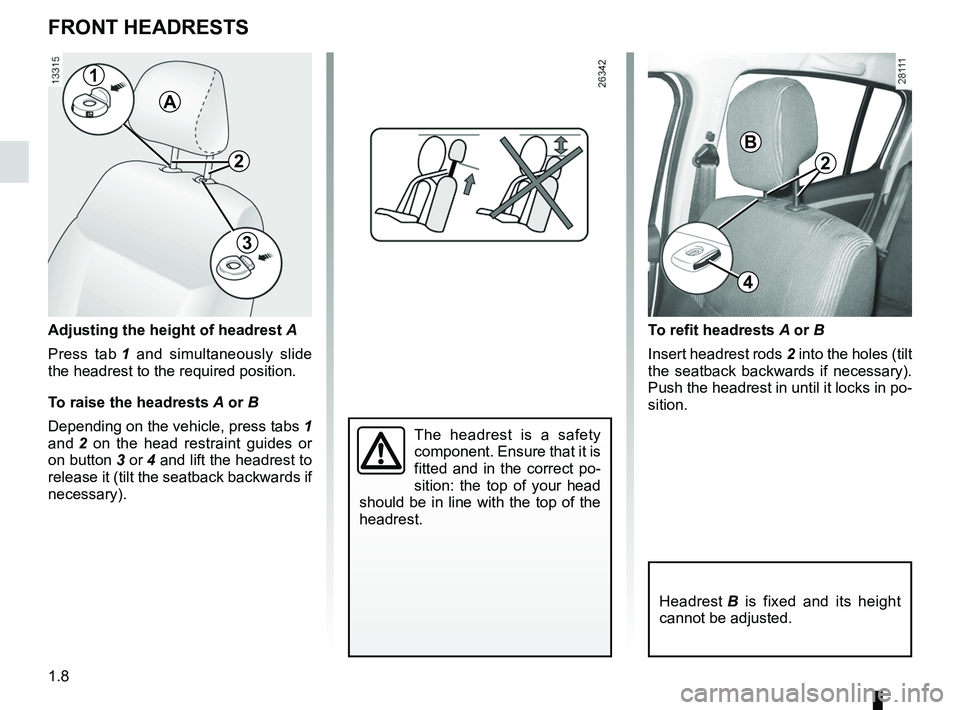
headrest................................................ (up to the end of the DU)
1.8
ENG_UD17760_7
Appuis-tête avant (B90 - Dacia)
ENG_NU_817-9_B90_Dacia_1
Front headrests
FRONT HEADRESTS
The headrest is a safety
component. Ensure that it is
fitted and in the correct po-
sition: the top of your head
should be in line with the top of the
headrest.
1
3
2
B
To refit headrests A or B
Insert headrest rods 2 into the holes (tilt
the seatback backwards if necessary).
Push the headrest in until it locks in po-
sition.
Headrest B is fixed and its height
cannot be adjusted.
Adjusting the height of headrest A
Press tab 1 and simultaneously slide
the headrest to the required position.
To raise the headrests A or B
Depending on the vehicle, press tabs 1
and 2 on the head restraint guides or
on button 3 or 4 and lift the headrest to
release it (tilt the seatback backwards if
necessary).
A
2
4
Page 15 of 183
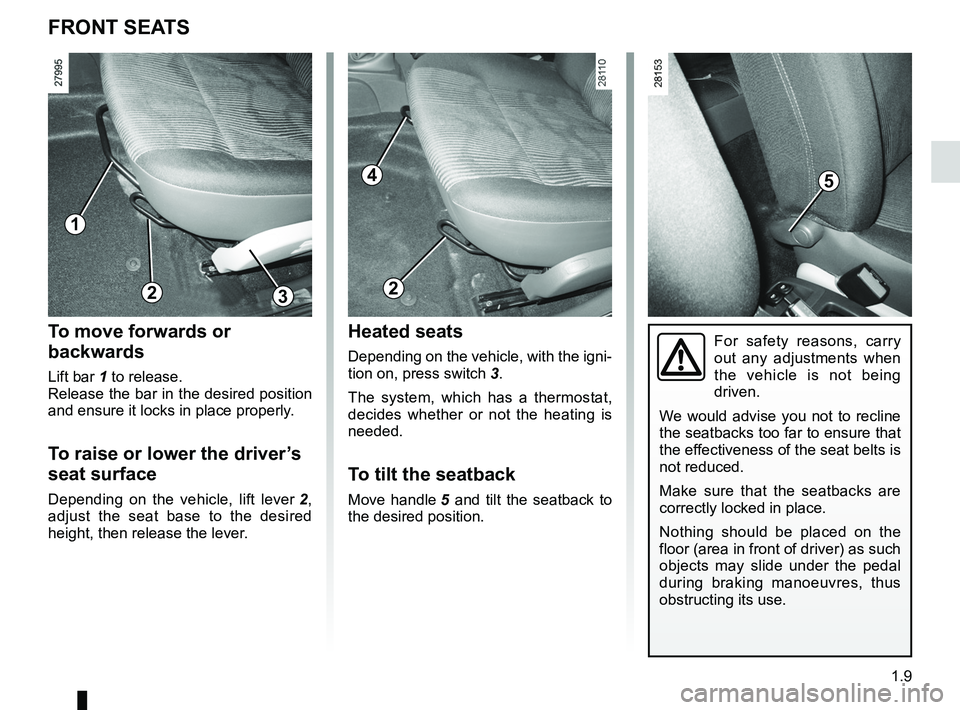
front seat adjustment ............................(up to the end of the DU)
front seats adjustment ...................................... (up to the end of the DU)
1.9
ENG_UD17772_6
Sièges avant (B90 - Dacia)
ENG_NU_817-9_B90_Dacia_1
Front seats
FRONT SEATS
For safety reasons, carry
out any adjustments when
the vehicle is not being
driven.
We would advise you not to recline
the seatbacks too far to ensure that
the effectiveness of the seat belts is
not reduced.
Make sure that the seatbacks are
correctly locked in place.
Nothing should be placed on the
floor (area in front of driver) as such
objects may slide under the pedal
during braking manoeuvres, thus
obstructing its use.
1
23
4
2
5
To move forwards or
backwards
Lift bar 1 to release.
Release the bar in the desired position
and ensure it locks in place properly.
To raise or lower the driver’s
seat surface
Depending on the vehicle, lift lever 2 ,
adjust the seat base to the desired
height, then release the lever.
Heated seats
Depending on the vehicle, with the igni -
tion on, press switch 3.
The system, which has a thermostat,
decides whether or not the heating is
needed.
To tilt the seatback
Move handle 5 and tilt the seatback to
the desired position.
Page 16 of 183
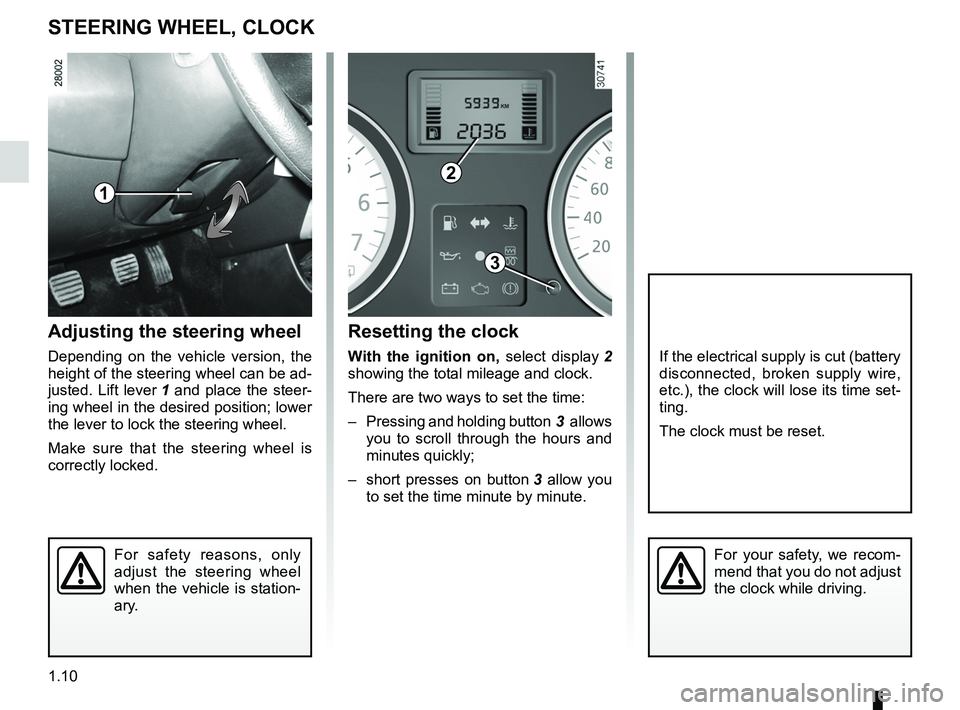
clock ..................................................... (up to the end of the DU)
clock ..................................................... (up to the end of the DU)
control instruments ................................................ (current page)
steering wheel adjustment ...................................... (up to the end of the DU)
1.10
ENG_UD20447_10
Volant de direction/Heure (B90 - L90 Ph2 - F90 Ph2 - R90 Ph2 - Dacia)
ENG_NU_817-9_B90_Dacia_1
Steering wheel, Clock
STEERING WHEEL, CLOCK
Adjusting the steering wheel
Depending on the vehicle version, the
height of the steering wheel can be ad-
justed. Lift lever 1 and place the steer-
ing wheel in the desired position; lower
the lever to lock the steering wheel.
Make sure that the steering wheel is
correctly locked.
For safety reasons, only
adjust the steering wheel
when the vehicle is station-
ary.
If the electrical supply is cut (battery
disconnected, broken supply wire,
etc.), the clock will lose its time set-
ting.
The clock must be reset.
Resetting the clock
With the ignition on, select display 2
showing the total mileage and clock.
There are two ways to set the time:
– Pressing and holding button 3 allows
you to scroll through the hours and
minutes quickly;
– short presses on button 3 allow you
to set the time minute by minute.
2
1
For your safety, we recom -
mend that you do not adjust
the clock while driving.
2
3
Page 17 of 183
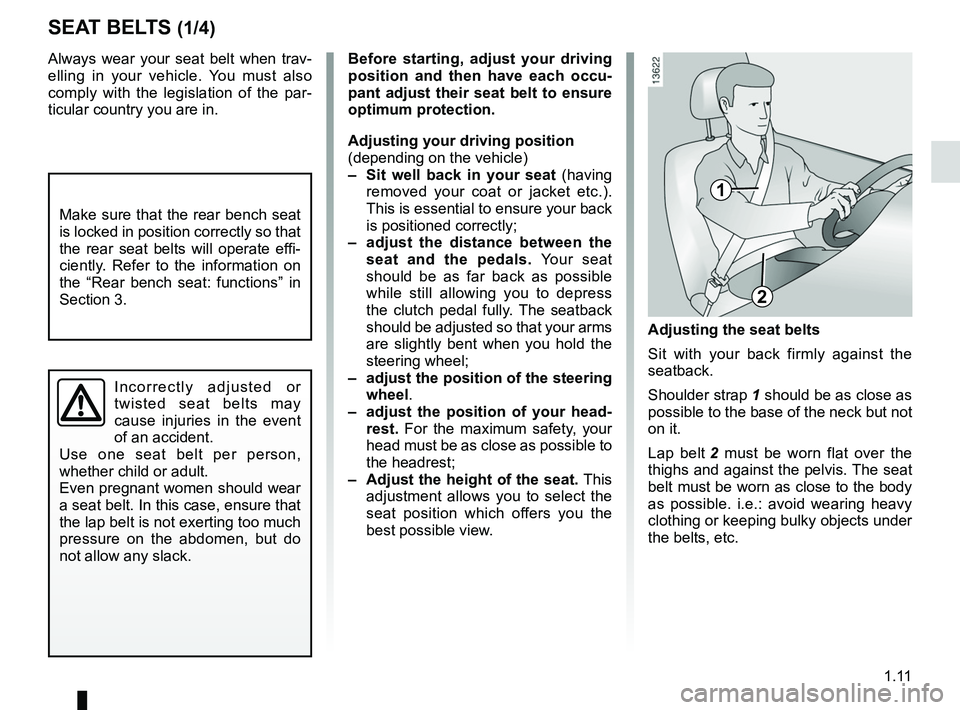
adjusting your driving position .............. (up to the end of the DU)
1.11
ENG_UD22593_8
Ceintures de sécurité (B90 - Dacia)
ENG_NU_817-9_B90_Dacia_1
Seat belts
Always wear your seat belt when trav-
elling in your vehicle. You must also
comply with the legislation of the par -
ticular country you are in.
Make sure that the rear bench seat
is locked in position correctly so that
the rear seat belts will operate effi -
ciently. Refer to the information on
the “Rear bench seat: functions” in
Section 3.
I n c o r r e c t l y a d j u s t e d o r
twisted seat belts may
cause injuries in the event
of an accident.
Use one seat belt per person,
whether child or adult.
Even pregnant women should wear
a seat belt. In this case, ensure that
the lap belt is not exerting too much
pressure on the abdomen, but do
not allow any slack.
Before starting, adjust your driving
position and then have each occu -
pant adjust their seat belt to ensure
optimum protection.
Adjusting your driving position
(depending on the vehicle)
– Sit well back in your seat (having
removed your coat or jacket etc.).
This is essential to ensure your back
is positioned correctly;
– adjust the distance between the
seat and the pedals. Your seat
should be as far back as possible
while still allowing you to depress
the clutch pedal fully. The seatback
should be adjusted so that your arms
are slightly bent when you hold the
steering wheel;
– adjust the position of the steering
wheel.
– adjust the position of your head -
rest. For the maximum safety, your
head must be as close as possible to
the headrest;
– Adjust the height of the seat. This
adjustment allows you to select the
seat position which offers you the
best possible view. Adjusting the seat belts
Sit with your back firmly against the
seatback.
Shoulder strap 1 should be as close as
possible to the base of the neck but not
on it.
Lap belt
2 must be worn flat over the
thighs and against the pelvis. The seat
belt must be worn as close to the body
as possible. i.e.: avoid wearing heavy
clothing or keeping bulky objects under
the belts, etc.
1
2
SEAT BELTS (1/4)
Page 18 of 183

1.12
ENG_UD22593_8
Ceintures de sécurité (B90 - Dacia)
ENG_NU_817-9_B90_Dacia_1
Jaune NoirNoir texte
Adjusting the front seat belt
height
(depending on the vehicle)
Move button 7 to select the position you
require so that chest strap 3 is worn as
described above.
Make sure that the seat belt is locked
in position correctly after you have ad-
justed it.
To fasten
Unwind the belt slowly and smoothly
and ensure that buckle 4 locks into
catch 6 (check that it is locked by pull -
ing on buckle 4). If the belt jams, allow
it to return slightly before attempting to
unwind it again.
If your seat belt is completely jammed,
pull slowly, but firmly, so that just over
3 cm unwinds. Allow it to return slightly
before attempting to unwind it again.
If there is still a problem, contact an ap-
proved dealer.
6
3
45
6
7
SEAT BELTS (2/4)
Unlocking
Press button 5 on catch 6; the seat belt
is wound up by the inertia reel. Guide
the buckle to facilitate this manoeuvre.
ßSeat belt reminder light
Depending on the vehicle, it
comes on when the engine is started
if the driver’s seat belt is not fastened.
When the vehicle is being driven, it
comes on and a beep sounds for ap -
proximately 2 minutes until the driver’s
seat belt is fastened.
Page 19 of 183
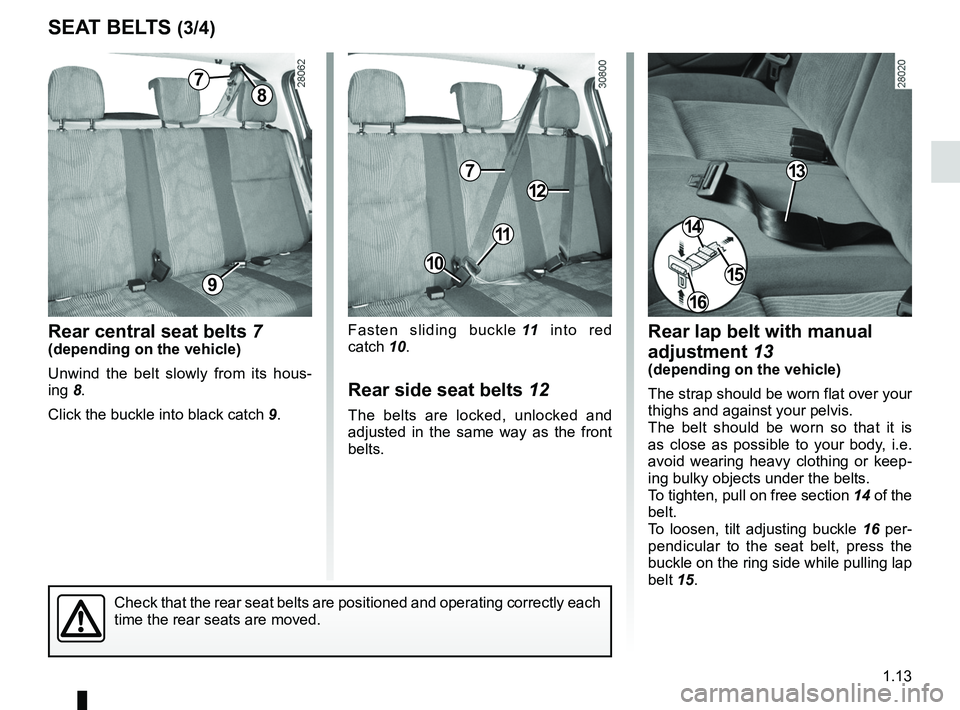
JauneNoirNoir texte
1.13
ENG_UD22593_8
Ceintures de sécurité (B90 - Dacia)
ENG_NU_817-9_B90_Dacia_1
SEAT BELTS (3/4)
Rear central seat belts 7(depending on the vehicle)
Unwind the belt slowly from its hous -
ing 8.
Click the buckle into black catch 9.Fasten sliding buckle
11 into red
catch 10.
Rear side seat belts 12
The belts are locked, unlocked and
adjusted in the same way as the front
belts.
Rear lap belt with manual
adjustment 13
(depending on the vehicle)
The strap should be worn flat over your
thighs and against your pelvis.
The belt should be worn so that it is
as close as possible to your body, i.e.
avoid wearing heavy clothing or keep -
ing bulky objects under the belts.
To tighten, pull on free section 14 of the
belt.
To loosen, tilt adjusting buckle 16 per -
pendicular to the seat belt, press the
buckle on the ring side while pulling lap
belt 15.
Check that the rear seat belts are positioned and operating correctly each
time the rear seats are moved.
78
9
10
14
15
11
16
137
12
Page 20 of 183
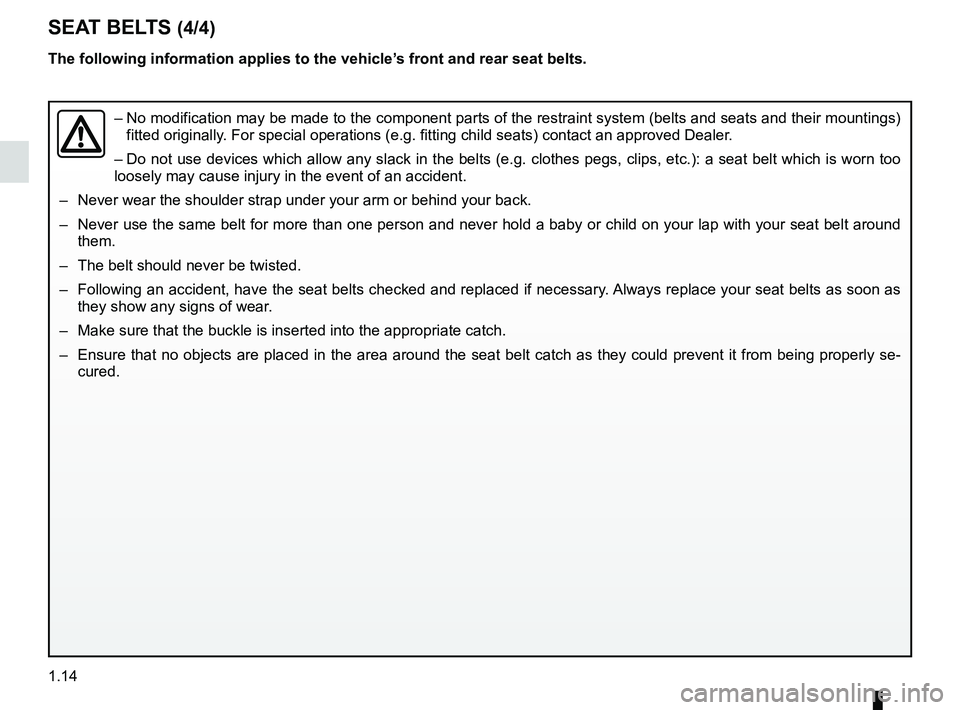
seat belts .............................................. (up to the end of the DU)
children ................................................. (up to the end of the DU)
1.14
ENG_UD22593_8
Ceintures de sécurité (B90 - Dacia)
ENG_NU_817-9_B90_Dacia_1
The following information applies to the vehicle’s front and rear seat belts.
– No modification may be made to the component parts of the restraint system (belts and seats and their mountings)
fitted originally. For special operations (e.g. fitting child seats) contact an approve\
d Dealer.
– Do not use devices which allow any slack in the belts (e.g. clothes pegs, clips, etc.): a seat belt which is worn too
loosely may cause injury in the event of an accident.
– Never wear the shoulder strap under your arm or behind your back.
– Never use the same belt for more than one person and never hold a baby or child on your lap with your seat belt around
them.
– The belt should never be twisted.
– Following an accident, have the seat belts checked and replaced if necessary. Always replace your seat belts as soon as
they show any signs of wear.
– Make sure that the buckle is inserted into the appropriate catch.
– Ensure that no objects are placed in the area around the seat belt catch as they could prevent it from being properly se-
cured.
SEAT BELTS (4/4)